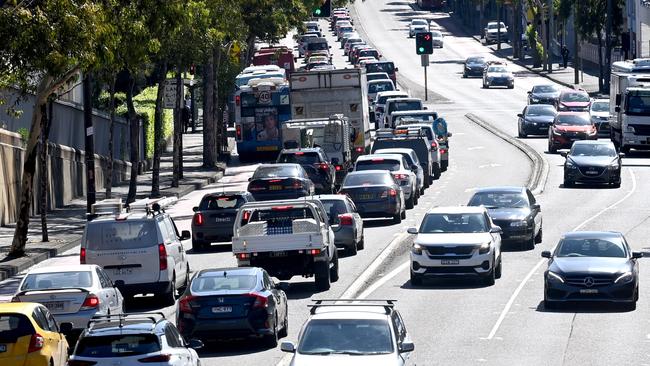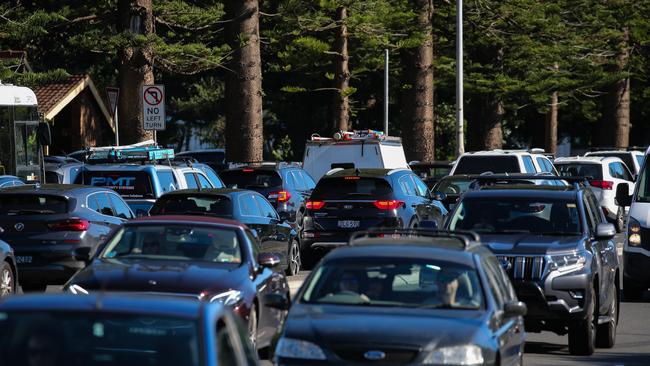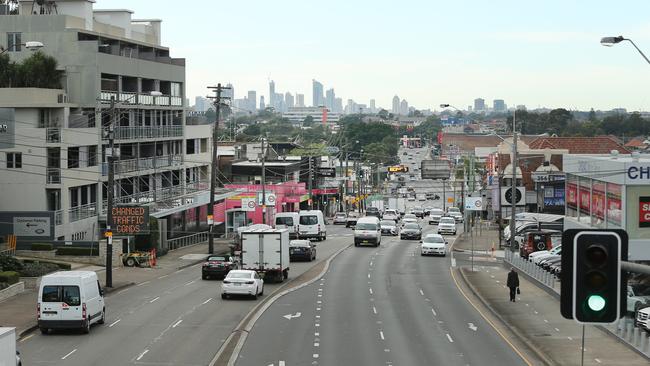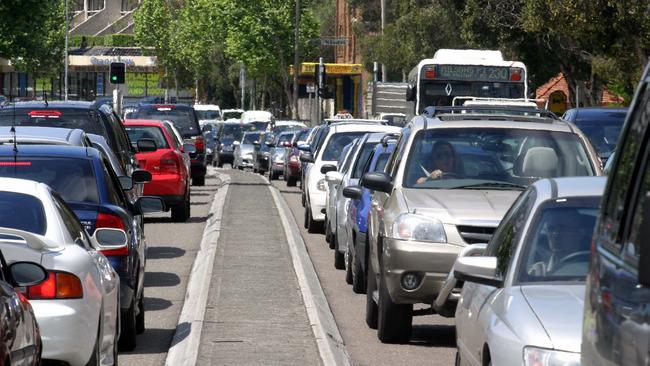New mapping reveals Sydney traffic speeds slowing on key major roads as population, car ownership rises
Modelling of Sydney’s major thoroughfares has shown traffic congestion is more banked up than ever as drivers limp along at average speeds less than half the signposted limits. See the list.
Local
Don't miss out on the headlines from Local. Followed categories will be added to My News.
Motorists are being forced to crawl at a snail’s pace on some of Sydney’s key arterial roads as new figures reveal average travel speeds are lagging more than 50 per cent below signposted speed limits.
Modelling of the city’s major thoroughfares has shown traffic congestion is more banked up than ever as drivers limp along at average speeds as low as 26km/h in 60km/h zones during peak hour periods.
Digital mapping and location data by global location data and technology company Here Technologies compared average speeds on five key Sydney roads during morning periods between April this year to the same period in 2022.
On the Spit Bridge – the main thoroughfare linked from the northern beaches to the city – cars in April this year were moving at average travel speeds of just 28.1km/h – less than half the 60km/h limit and almost five kilometres slower than in 2022.
It was only marginally better on the Cahill Expressway in the CBD with motorists travelling at average speeds of 30.86km/h.

On the notoriously busy Parramatta Rd corridor, average speeds were measured at 36.5km/h at Auburn – three kilometres slower than the same period in 2022.
Pennant Hills Rd recorded average travel speeds of 40.3km/h hour – two kilometres slower than the previous year but a slight improvement from the 39.58km/h average speed in 2023.
The figures come despite the completion of recent infrastructure projects that were touted as ‘congestion busting’ upgrades designed to improve travel times on the city’s worst snarl points.

NRMA spokesman Peter Khoury said the worsening congestion on Sydney’s roads could reflect increased car ownership and population growth.
“Traffic volumes have come back to pre-Covid levels and population growth has also been a factor particularly in western and southwest Sydney which impacts roads like Parramatta Rd,” he said.

“There’s no doubt traffic volumes are increasing (and) that’s leading to more frustration on roads.
“There have been a lot of major infrastructure projects completed in Sydney in recent years but there are always improvements that can be made with things like public transport and road technology.
“As a global city we need infrastructure that can handle the capacity.”

Daniel Antonello, Here Technologies general manager for Australia and New Zealand, said the figures showed traffic congestion in Sydney continued to be a longstanding challenge for commuters and city planners.
As well as causing frustrations for motorists, the congestion is also having an impact on productivity for businesses.
“Key traffic corridors are often gridlocked during peak hours, with some even reflecting higher congestion over the years,” Mr Antonello said.
“This trend underscores the need for strategic planning and innovative solutions to deliver smarter, more efficient traffic management solutions to ease congestion and improve the quality of urban life.”
Transport for NSW, in a statement, said the NSW Government was “making significant investment in relieving congestion on Sydney’s roads” through major projects such as the Warringah Freeway Upgrade, Western Harbour Tunnel, the M12 and smaller projects aimed at alleviating local traffic pinch points across Sydney.
“Additionally, there is a 24/7 focus on minimising disruptions and maximising traffic flow reliability across Sydney’s road network,” a spokesman said.
“The Transport Management Centre responds swiftly to clear incidents such as crashes and breakdowns and addressing congestion on the road network, by employing measures such as deploying rapid response field resources, adjusting traffic light phasing and utilising Smart Motorway technologies on major roads around the city to optimise traffic flows.
“Through these proactive measures and investments, the NSW Government is committed to enhancing travel time reliability and improving commuter experiences across Sydney.”
CAHILL EXPRESSWAY
Average speeds Thursday: 30.86km/h (slower than 32.04km/h in 2022)
Average speeds Saturday: 36.36km/h (slower than 37.70km/h in 2022)
PARRAMATTA ROAD
Average speeds Thursday: 36.55km/h (slower than 39.09km/h in 2022)
Average speeds Saturday: 44.13km/h (slower than 44.53km/h in 2022)
PENNANT HILLS ROAD
Average speeds Thursday: 40.31km/h (faster than 39.58km/h in 2022)
Average speeds Saturday: 47.03km/h (faster than 44.38km/h in 2022)
SPIT BRIDGE
Average speeds Thursday: 28.10km/h (slower than 33.01km/h in 2022)
Average speeds Saturday: 37.53km/h (slower than 39.10km/h in 2022)
ROZELLE INTERCHANGE
Average speeds Thursday: 28.56km/h (faster than 26.88km/h in 2022)
Average speeds Saturday: 33.50km/h (faster than 33.16km/h in 2022)





